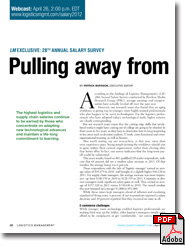Logistics Management’s 2012 Salary Survey
The highest logistics and supply chain salaries continue to be earned by those who concentrate on adapting new technological advances and maintain a life-long commitment to learning.

According to the findings of Logistics Management’s (LM) 28th Annual Salary Survey conducted by Peerless Media Research Group (PRG), average earnings and compensation have actually leveled off over the past year.
However, our research team also found that an aging workforce is giving way to younger, more highly trained professionals who also happen to be savvy technologists. For the logistics professionals who have adopted today’s technological tools, higher salaries are clearly corresponding.
But our research team warns that the cutting edge skills that newly-hired workers might have coming out of college are going to be obsolete in three years to five years, so they have to determine how to keep improving in key areas such as decision analysis, IT tools, cross-functional and cross-organizational teaming, as well as finance.
Also worth noting, say our researchers, is that now, more than ever, experience pays. Young people joining the workforce should aim to grow within their current organization, rather than chasing after that better offer. In fact, our survey indicates that the long-term payoff could be substantial.
This year’s results, based on 801 qualified LM reader respondents, indicate that 64 percent did see a modest salary increase in 2011. Of that number, the average bump was 6 percent.
Those respondents with the title of “logistic manager” earned an average salary of $95,479 in 2010 and brought in a slightly higher $96,120 in 2011. For supply chain managers, the average increase was more impressive: up from $100,159 in 2010 to $128,335 in 2011. Corporate or division managers made significant salary gains as well. They earned an average of $157,320 in 2011 versus $138,630 in 2010. The overall median this year bumped up a meager $1,000 to $91,000.
While these raises kept managers ahead of inflation and escalating standard-of-living costs, 6 percent of our respondents reported a salary decrease and 30 percent reported that they received no raise at all.

E-commerce challenges
While younger, more technology-enabled logistics professionals are making their way up the ladder, older logistics managers simply can’t afford to be complacent or get “comfortable,” our survey indicates. Educators and executive recruiters echoed this sentiment during interviews in the weeks immediately following the release of this year’s salary survey data.
“Talent management—recruitment, development, and retention—is an increasing challenge across many fronts in supply chain management as the discipline and business becomes more complex,” says Dr. Theodore Stank, professor of logistics at the University of Tennessee.
He says that the move toward e-commerce is just one way that “old dogs” have to learn new tricks, while companies are also struggling to find people with good decision analysis skills in order to use all of the new data available to them.

“Most organizations do not have a well-articulated talent management strategy,” says Stank. “Business executives need to ask a number of key questions: What kinds of new people do they need to buy from the market? What can they develop in the people they already have? How do they keep people progressing in their careers to deal with tomorrow’s new challenges? The companies that are figuring this out first are winning the war for talent.”
The Logistics Management and PRG research teams also found that logistics professionals with a skill set including information technology are among the highest paid. This did not surprise Stank. His advice for young and old alike is to “stay thirsty, my friends.” He believes that everyone at a management level must be committed to a lifetime of learning.

“Key areas such as decision analysis, IT tools, cross-functional and cross-organizational teaming and interaction, along with finance will remain in demand,” says Stank. “Logistics mangers should pursue online coursework, executive education, professional certification—all geared toward shoring up gaps in current skill sets and adding new skill sets that are required for their next promotion or for the realities of the world in 3 to 5 years.”
Dr. Bruce Arntzen, executive director of the supply chain management program at MIT, says that students who have already worked in supply chain for a few years will benefit much more from the supply chain management program than a student coming right out of undergraduate programs—and they will be rewarded much better financially as well.
 “Yesterday, if you had a college degree you had a leg up on the competition,” says Arntzen. “Today you need to have a master’s degree. Interestingly, about a third of the students who are getting their master’s degree in supply chain at MIT already have an MBA or a master’s degree in some other field already, so these students will have two.”
“Yesterday, if you had a college degree you had a leg up on the competition,” says Arntzen. “Today you need to have a master’s degree. Interestingly, about a third of the students who are getting their master’s degree in supply chain at MIT already have an MBA or a master’s degree in some other field already, so these students will have two.”
Meanwhile, adds Arntzen, veterans must resist the idea of becoming “comfortable” in their current positions. “More than anyone else, these people must be the agents of change,” he says. “They must embrace new technology and champion its implementation. Otherwise, co-workers and management may suspect that they may be part of the problem rather than the solution.”
Experience still matters
That fact that logistics managers in the 65-year-old bracket are still pulling down six-figure salaries demonstrates that experience still matters. As our research indicates, the 55-year-old to 64-year-old group represents today’s top earners.
Lynn Failing, vice president of Kimmel & Associates Inc., a national executive search firm specializing in the logistics and supply chain, says that the best supply chain professionals are those who understand the “links” in the supply chain.
“This age group demonstrates the value of remaining passionate about their work,” says Failing. “The lesson here is that if you’re starting out in planning, try a stint in operations. If you’re in procurement, try your hand in IT. If you’re in materials management, move over to logistics. Remember that being smart is only half the story. Take the time to learn to be wise…and never stand still.”
 The same can’t be said for moving from one geographic area to another; however, as our survey shows, working in the nation’s heartland has some clear economic advantages. Not only is the cost of living lower there, the concentration of manufacturing and heavy industry remains rooted in this region.
The same can’t be said for moving from one geographic area to another; however, as our survey shows, working in the nation’s heartland has some clear economic advantages. Not only is the cost of living lower there, the concentration of manufacturing and heavy industry remains rooted in this region.
While not leading the pack in base salary levels, 36 percent of this year’s respondents came from the Midwest, earning an average of $106,835. The Southeast earned the highest average salary at $117,100, New England respondents earned an average $109,575, and the West earned an average $102,465.
And while our research did not measure the impact of outsourcing the logistics function, many managers told us that nearshoring is a trend that can only drive the demand for domestic expertise.
“Increased awareness of supply chain risks—especially incumbent in long-distant supply chains—will motivate companies to seek to locate production near their customer base. This favors on-shoring,” adds Arntzen.
Building a career foundation
Anecdotal evidence gathered by LM after the survey was completed confirmed that veterans want to share their experience with younger co-workers.
Barry Smith, supply chain director for Lincoln Electric in Cleveland observes that recent graduates may have unrealistic expectations. “There has been a significant inflation on starting salaries in some areas,” he says. “But employers are not going to reward new hires unless they have proven technical expertise.”
The “entitlement” generation may be in for a rude awakening, says Brad Larsen, transportation and logistics manager for Winegard Company in Burlington, Ind. “Most of my age group had to start out in the trenches and learn on the fly to get where we are today,” he says. “After 25 years, we have a good grasp on where things are headed and should be at a good spot in our careers compensation wise.”
“Having graduates ready to contribute right away is vital,” he says. “But it will be recognized and rewarded.”
“Today’s young people have to be prepared to climb the corporate ladder,” says Art Meyer, warehouse, equipment and purchasing manager for NPL Construction Company in Dallas.
“Education is a big advantage, but they really must have a work ethic to succeed and earn the salary they desire.”
Allen Masters, head of central stores resource management for the University of Florida in Gainesville, agrees, but says “climbing that ladder” is easier in the private sector, rather than within “a state agency.”
Bob Stone, regional sales manager for Right Freight Solutions in Townville, S.C., says that the private sector is providing more incentives for college graduates to pursue a career in logistics. “We never have trouble attracting young people to this business,” he says. “But keeping them in one position is difficult. Many of them go through three to four jobs before they settle down.”
Getting them to “settle down” might be made easier by providing bonuses based on performance, says Brenda Gautier, director of carrier engagement for MW Logistics, LLC in Dallas. “Given the added responsibilities logistics managers are taking on these days, we expect them to work smarter and be more efficient,” she says. “And if they can contribute to the company’s bottom line, they should get something beyond their salary at the end of the year.”

Article Topics
E-commerce News & Resources
Solving the last-mile delivery issue in New York City UPS is set to take over USPS air cargo contract from FedEx UPS presents updated financial goals and strategic targets at its investor day FedEx fiscal third quarter earnings see gains amid ongoing volume declines National Retail Federation 2024 retail sales forecast calls for growth Will recent talks between FedEx and Amazon lead to a reunion? February retail sales see gains, reports Commerce and NRF More E-commerceLatest in Logistics
Diesel back over $4 a gallon; Mideast tensions, other worries cited Four U.S. railroads file challenges against FRA’s two-person crew mandate, says report XPO opens up three new services acquired through auction of Yellow’s properties and assets FTR’s Trucking Conditions Index weakens, due to fuel price gains U.S. rail carload and intermodal volumes are mixed, for week ending April 6, reports AAR LM Podcast Series: Examining the freight railroad and intermodal markets with Tony Hatch Supply Chain Stability Index sees ‘Tremendous Improvement’ in 2023 More LogisticsAbout the Author
Subscribe to Logistics Management Magazine

Find out what the world's most innovative companies are doing to improve productivity in their plants and distribution centers.
Start your FREE subscription today.
April 2023 Logistics Management

Latest Resources















